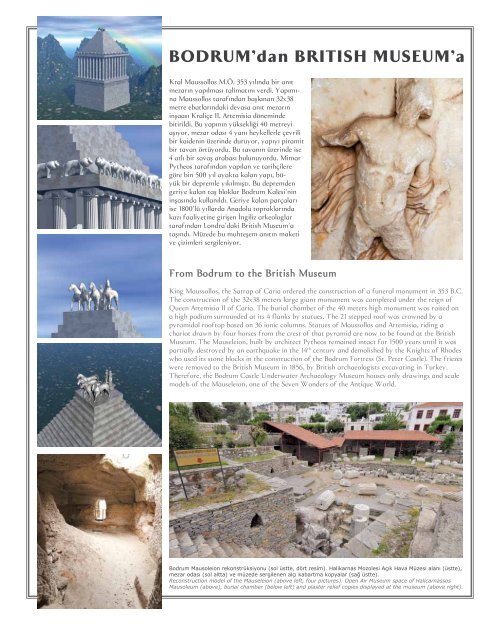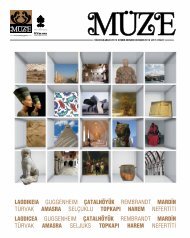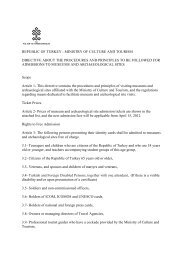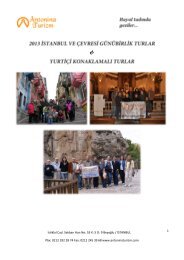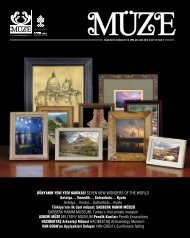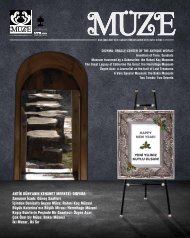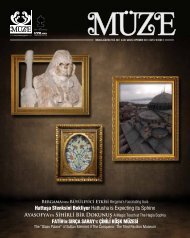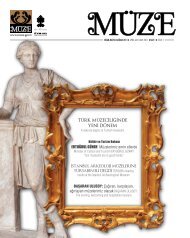GAZİANTEP ZEUGMA MOZAİK MÜZESİ
GAZİANTEP ZEUGMA MOZAİK MÜZESİ
GAZİANTEP ZEUGMA MOZAİK MÜZESİ
You also want an ePaper? Increase the reach of your titles
YUMPU automatically turns print PDFs into web optimized ePapers that Google loves.
BODRUM’dan BRITISH MUSEUM’a<br />
Kral Maussollos M.Ö. 353 yılında bir anıt<br />
mezarın yapılması talimatını verdi. Yapımına<br />
Maussollos tarafından başlanan 32x38<br />
metre ebatlarındaki devasa anıt mezarın<br />
inşaası Kraliçe II. Artemisia döneminde<br />
bitirildi. Bu yapının yüksekliği 40 metreyi<br />
aşıyor, mezar odası 4 yanı heykellerle çevrili<br />
bir kaidenin üzerinde duruyor, yapıyı piramit<br />
bir tavan örtüyordu. Bu tavanın üzerinde ise<br />
4 atlı bir savaş arabası bulunuyordu. Mimar<br />
Pytheos tarafından yapılan ve tarihçilere<br />
göre bin 500 yıl ayakta kalan yapı, büyük<br />
bir depremle yıkılmıştı. Bu depremden<br />
geriye kalan taş bloklar Bodrum Kalesi’nin<br />
inşasında kullanıldı. Geriye kalan parçaları<br />
ise 1800’lü yıllarda Anadolu topraklarında<br />
kazı faaliyetine girişen İngiliz arkeologlar<br />
tarafından Londra’daki British Museum’a<br />
taşındı. Müzede bu muhteşem anıtın maketi<br />
ve çizimleri sergileniyor.<br />
From Bodrum to the British Museum<br />
King Maussollos, the Satrap of Caria ordered the construction of a funeral monument in 353 B.C.<br />
The construction of the 32x38 meters large giant monument was completed under the reign of<br />
Queen Artemisia II of Caria. The burial chamber of the 40 meters high monument was raised on<br />
a high podium surrounded at its 4 flanks by statues. The 21 stepped roof was crowned by a<br />
pyramidal rooftop based on 36 ionic columns. Statues of Maussollos and Artemisia, riding a<br />
chariot drawn by four horses from the crest of that pyramid are now to be found at the British<br />
Museum. The Mauseleion, built by architect Pytheos remained intact for 1500 years until it was<br />
partially destroyed by an earthquake in the 14 th century and demolished by the Knights of Rhodes<br />
who used its stone blocks in the construction of the Bodrum Fortress (St. Peter Castle). The friezes<br />
were removed to the British Museum in 1856, by British archaeologists excavating in Turkey.<br />
Therefore, the Bodrum Castle Underwater Archaeology Museum houses only drawings and scale<br />
models of the Mauseleion, one of the Seven Wonders of the Antique World.<br />
Bodrum Mausoleion rekonstrüksiyonu (sol üstte, dört resim). Halikarnas Mozolesi Açık Hava Müzesi alanı (üstte),<br />
mezar odası (sol altta) ve müzede sergilenen alçı kabartma kopyalar (sağ üstte).<br />
Reconstruction model of the Mauseleion (above left, four pictures). Open Air Museum space of Halicarnassos<br />
Mausoleum (above), burial chamber (below left) and plaster relief copies displayed at the museum (above right).


